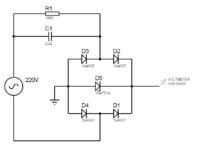- Joined
- Jan 22, 2008
- Messages
- 52,513
- Helped
- 14,758
- Reputation
- 29,798
- Reaction score
- 14,128
- Trophy points
- 1,393
- Location
- Bochum, Germany
- Activity points
- 298,482
The regulator can't work with a constant current capacitor supply, power dissipation would be too high.It looks like there was originally a regulator and protection but the manufacturer removed it and linked across it to cut costs.


